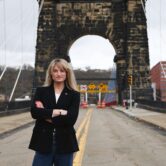HONOLULU (CN) — It’s set up like an old-timey candy store, but the glass jars here aren’t filled with taffy, peppermints or gumballs.
Instead, the jars at the Crack Seed Store, a bustling snack shop on Honolulu’s southside, display an array of preserved fruits, rice crackers and other local Hawaii snacks. These snacks would be hard to find on the mainland, and even in Hawaii they’re increasingly rare.
The choices here are almost overwhelming. There’s standard plum, along with ginger, lemon, lychee and countless other fruits, each preserved in various sweet, salty and even spicy flavors.
I don’t often come to the Crack Seed Store, but the snacks they sell — food I’ve grown up eating — still feel familiar. Where grandmothers on the mainland may hand out hard candies to their grandchildren, my po-po would instead shake out li hing mui from jars, telling my sister and I to be careful of the seed in the middle.
Li hing mui — a salty, sweet and tart dried plum — has become one of my tried-and-true favorites. Dried mango is another. Still, with so many jars lining the walls of the cramped store, all colorful and inviting, it’s hard not to want to stray.
Noticing my hesitation, a woman behind the counter asks if I’d like to taste test anything. I select a couple pieces of ginger. She fishes them straight from a jar.
The honey flavor is popular, she tells me — but she thinks I could brave the spicy version. Each piece has a distinct sour tang, but I’m not sure this shopkeep is right about my tastes. The hit of the ginger, combined with spice from the marinade it’s been steeping in, may be too much for me.
The food I’m trying is “crack seed” — a Hawaii snack with serious flavor and a silly name. A Hawaii take on a classic Cantonese preparation, it’s a window into the unique history and food culture of this island state.
Some say “crack seed” gets its name from the addictive properties of crack cocaine. In fact, it comes from the way cooks crack the seeds of fruit to allow the marinade to penetrate more deeply. That marinade typically includes ingredients like licorice, salt and sugar.
It began as the Cantonese snack see mui, or preserved sour plum. From there, it was a natural jump to pickling different fruits in the same manner. When the snack landed in Hawaii, locals began making their own versions, applying see mui pickling techniques on tropical fruit like mango.
These days, the distinctive sour candy remains a hit in Hawaii. The Crack Seed Store has been operating for over seventy years, according to Liana Fang, whose family acquired the shop from the original owners in 2020.
Hawaii is well-known for its local cuisine, which draws from the unique blend cultures that settled on the islands from across the Pacific and beyond.
As immigrants from Japan, China, Korea, the Philippines, Portugal, and Puerto Rico came to the islands, they brought their food and culture with them. Over time, those cultures and flavors blended together, creating new and distinct Hawaii dishes and traditions.
Typically brought to the islands to work on sugarcane plantations, these immigrants were forced to work alongside each other. Although at first unable to communicate, they later developed a unique pidgin dialect that still influences local conversation today.
Another major part of this exchange was the food — including dishes that evolved from their Asian roots to become some of Hawaii’s most popular. Spam musubi evolved from Japanese rice balls, while Chinese char siu bao (steamed pork buns) became manapua, or “tasty meat thing” in Hawaiian.










